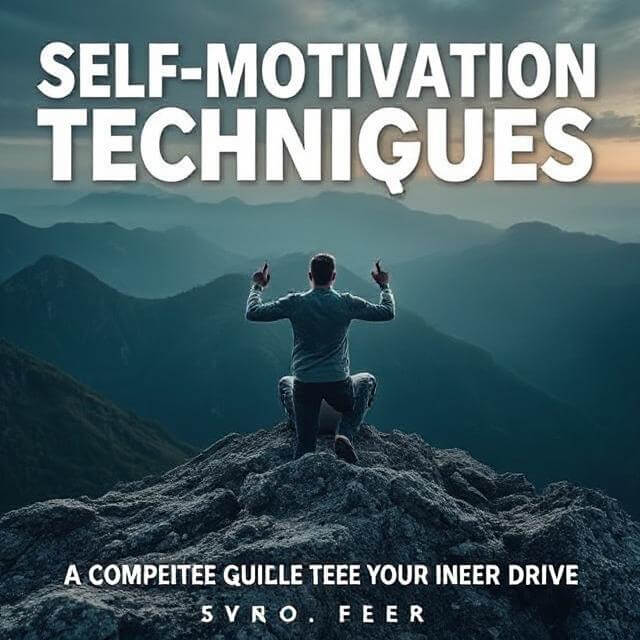Self-Motivation Techniques: A Complete Guide to Fueling Your Inner Drive
Introduction
Self-motivation is the engine that drives personal growth, resilience, and long-term success. It’s the inner force that pushes you to take action even when external rewards are absent. Whether you’re striving for academic excellence, professional achievement, or personal development, self-motivation is the differentiator between dreaming and doing.
Unlike external motivation, which depends on rewards or recognition, self-motivation stems from within. This article explores more than a dozen powerful self-motivation techniques, backed by psychology, neuroscience, and practical experience. Whether you’re battling procrastination, recovering from failure, or trying to build lasting habits, this comprehensive guide will equip you with the tools to stay inspired and take consistent action.
❤️ Learn Sufficient Notes ❤️
The Psychology of Self-Motivation
Understanding the psychology behind motivation is essential to improving it. Two types of motivation dominate human behavior:
- Intrinsic Motivation: Performing an activity for its inherent satisfaction. Examples include learning a new skill out of curiosity or exercising because it feels good.
- Extrinsic Motivation: Driven by external rewards like money, praise, or avoidance of punishment.
Studies in cognitive psychology show that intrinsic motivation leads to greater persistence, creativity, and satisfaction. The goal of self-motivation is to build intrinsic drive while strategically using extrinsic rewards when needed.
Core Principles of Self-Motivation
- Purpose: A deep understanding of “why” you want something fuels long-term drive.
- Autonomy: Feeling in control over your choices enhances motivation.
- Mastery: The desire to improve skills and overcome challenges.
- Progress: Seeing measurable results encourages continued effort.
- Resilience: The ability to bounce back from setbacks.
Self-Motivation Techniques
1. Set SMART Goals
Specific, Measurable, Achievable, Relevant, and Time-bound goals give direction and accountability. Break large goals into smaller milestones and track progress.
Example: Instead of saying “I want to be healthier,” say “I will walk 30 minutes every day for the next month.”
2. Use Visualization and Mental Rehearsal
Elite athletes and performers visualize success before they achieve it. Close your eyes and vividly imagine accomplishing your goal. Feel the emotions associated with victory.
Pro Tip: Practice visualization daily for 5–10 minutes.
3. Create a Vision Board
A vision board is a visual representation of your dreams and goals. It keeps your intentions visible and emotionally engaging.
Steps:
- Collect images, quotes, and symbols that inspire you.
- Paste them on a board or digital collage.
- Place it somewhere you’ll see daily.
4. Build Keystone Habits
Keystone habits create ripple effects across your life. Examples include waking up early, journaling, or regular exercise.
How to Build One:
- Start small and be consistent.
- Attach it to an existing routine.
- Celebrate small wins.
5. Practice Gratitude Daily
Gratitude shifts your focus from what’s lacking to what’s thriving. A grateful mindset fuels optimism and resilience.
Daily Exercise:
- Write down three things you’re grateful for each morning.
- Reflect on positive experiences at night.
6. Use Positive Affirmations
Affirmations help rewire your subconscious beliefs. Repeating positive, empowering statements boosts self-esteem and motivation.
Examples:
- “I am capable of achieving my goals.”
- “I grow stronger with every challenge.”
Also You Know About Scientific Topic With Us- Learn Sufficient Notes Scientific World
7. Monitor Your Self-Talk
Self-motivation dies in a toxic inner dialogue. Practice awareness and replace criticism with constructive coaching.
Replace:
- “I always fail” → “I learned something valuable.”
- “I can’t do this” → “This is tough, but I’m tougher.”

8. Apply the Pomodoro Technique
This time management method improves focus and momentum:
- Work for 25 minutes (1 Pomodoro).
- Take a 5-minute break.
- Repeat for four Pomodoros, then take a 15–30 minute break.
9. Use the 5-Second Rule
Mel Robbins’ 5-second rule is simple: when you feel the urge to act, count down “5-4-3-2-1” and then move. It disrupts hesitation and activates your prefrontal cortex.
10. Surround Yourself with Inspiration
Your environment influences your energy. Curate it deliberately:
- Read books and biographies of achievers.
- Watch motivational videos.
- Listen to uplifting music or podcasts.
11. Cultivate Discipline Over Motivation
Relying on motivation alone is unsustainable. Discipline builds consistency and is formed through repeated action regardless of mood.
Tip: Build routines, remove temptations, and automate good decisions.
12. Reward Yourself
Create a personal reward system to stay engaged. Rewards can be small (a coffee break) or big (a weekend trip).
Pro Tip: Align rewards with milestones to reinforce achievement.
13. Use Habit Trackers and Journals
Tracking progress helps visualize improvement and maintain momentum.
Tools:
- Apps like Habitica, Notion, or HabitBull.
- Bullet journals or printed templates.
14. Find Your “Why”
Dig deep into the reason behind your goals. Personal meaning sustains motivation through tough times.
Exercise:
- Ask “Why is this important to me?” five times to drill down to your core motivation.
15. Limit Distractions
Distractions dilute motivation. Create a distraction-free environment:
- Turn off notifications.
- Use website blockers.
- Designate focused work hours.
16. Embrace Failure and Learn From It
Failure is a stepping stone to growth. Use it as feedback, not a verdict.
Reflection Prompt: “What did I learn, and how can I apply it?”
17. Connect with Like-Minded People
Being part of a growth-minded community increases accountability and inspiration. Join groups, attend events, or find an accountability partner.
18. Get Enough Sleep and Exercise
Your physical health is the foundation of your mental drive. Prioritize 7–9 hours of sleep, stay hydrated, and move daily.
19. Practice Mindfulness and Meditation
Mindfulness reduces stress and improves emotional regulation. A clear, calm mind fosters better decisions and sustained effort.
Apps to Try: Headspace, Insight Timer, Calm.
20. Use the “Two-Minute Rule”
If a task takes less than two minutes, do it immediately. It builds momentum and reduces mental clutter.
Advanced Motivation Techniques
Leverage Identity-Based Habits (From James Clear)
Instead of saying “I want to run,” say “I’m a runner.” Align your behavior with your desired identity.
Framework:
- Decide the type of person you want to be.
- Prove it to yourself with small wins.
Design Motivation Routines
Anchor motivation into your routine using triggers (like music or movement). For example:
- Play a specific playlist before work sessions.
- Stretch before writing to signal focus.
Implement the WOOP Method
- Wish: What do you want?
- Outcome: What’s the best result?
- Obstacle: What might get in your way?
- Plan: What’s your plan to overcome it?
This evidence-based technique merges dreams with realistic planning.
Real-Life Examples of Self-Motivation
1. J.K. Rowling
Before becoming a billionaire author, she faced rejection from 12 publishers, battled depression, and lived on welfare. Her intrinsic drive to tell stories carried her through adversity.
2. Elon Musk
Despite multiple failed launches and near bankruptcy with SpaceX and Tesla, Musk stayed motivated by a vision of humanity’s future and innovation.
3. Thomas Edison
Famous for inventing the light bulb, Edison failed thousands of times but considered each failure a discovery of what didn’t work.
Also You can Learn Business With Us- Learn Sufficient Notes Business World
Challenges to Self-Motivation (and How to Overcome Them)
1. Lack of Clarity
Solution: Use SMART goals and journaling to define what you want and why.
2. Fear of Failure
Solution: Reframe failure as feedback and growth.
3. Low Energy
Solution: Improve diet, sleep, and exercise.
4. Negative Environment
Solution: Limit time with toxic people. Find or create positive spaces.
5. Perfectionism
Solution: Adopt a “progress over perfection” mindset. Take messy action.
Self-Motivation for Different Life Areas
Academic
- Use study groups and pomodoro.
- Set clear goals like grades or certifications.
Career
- Seek mentorship.
- Volunteer for projects that stretch your skills.
Fitness
- Use habit stacking (e.g., jog after brushing teeth).
- Track progress and reward consistency.
Creative Work
- Create before you consume.
- Use idea journals and creative routines.
Personal Growth
- Read daily.
- Practice reflection and continuous learning.
Final Thoughts
Self-motivation isn’t something you’re born with—it’s something you build. Like a muscle, it strengthens with consistent use and mindful practice. Start small, stay focused on your “why,” and use the techniques in this guide to craft a lifestyle where motivation flows naturally.
Every goal, whether big or small, begins with a single motivated decision. Today, let that decision be to take charge of your inner drive and create the life you envision.
End of Article





